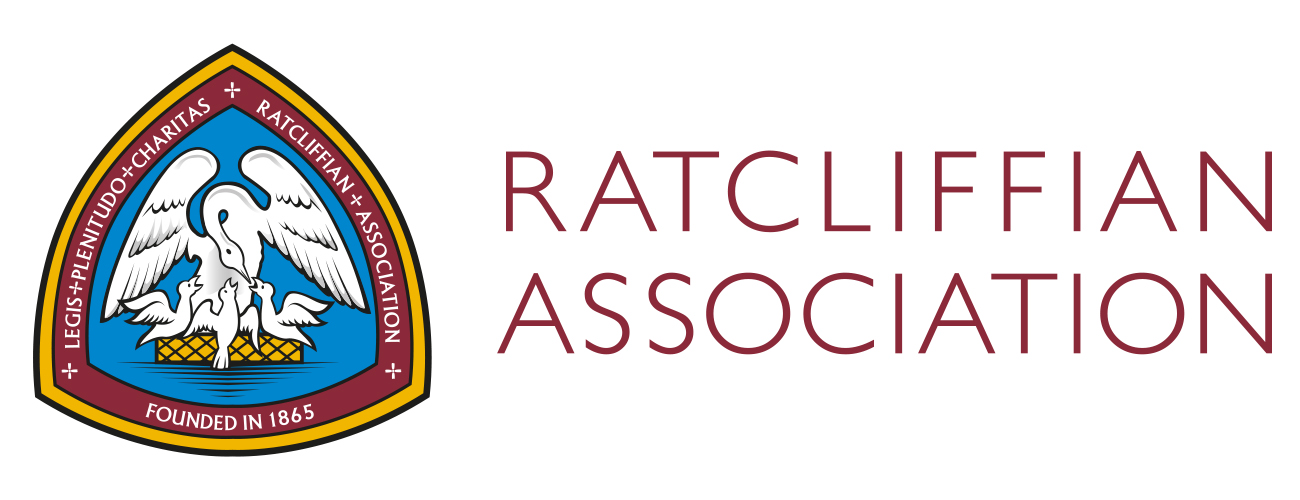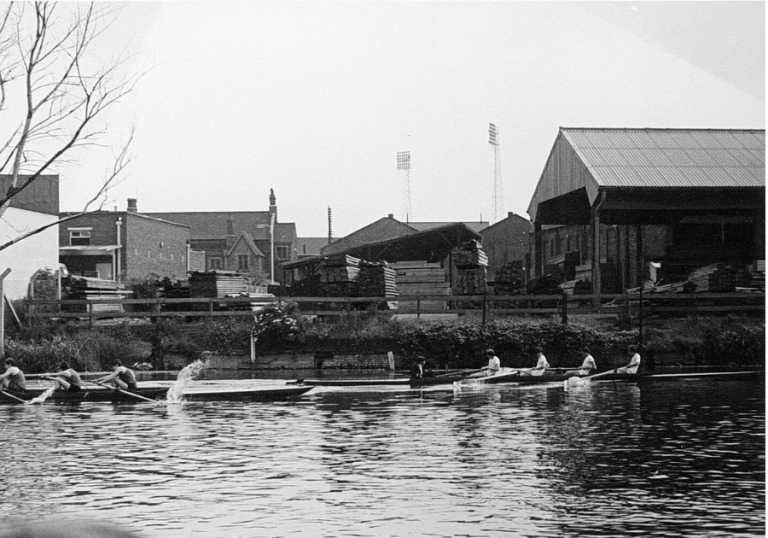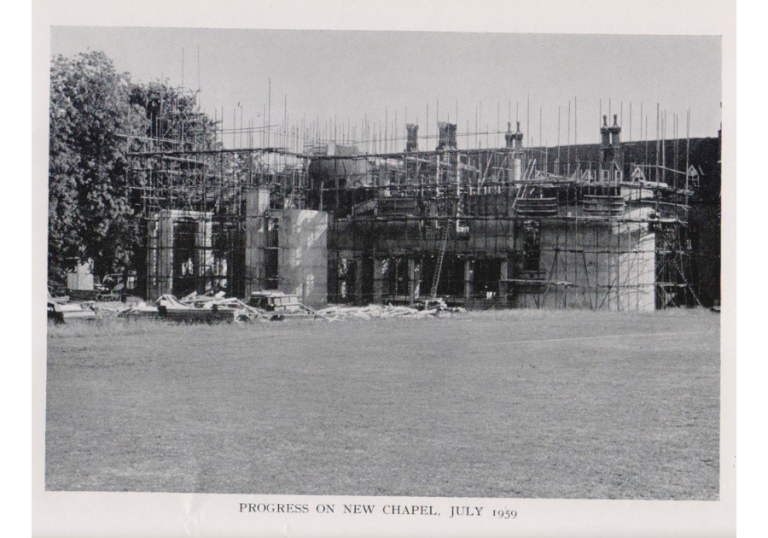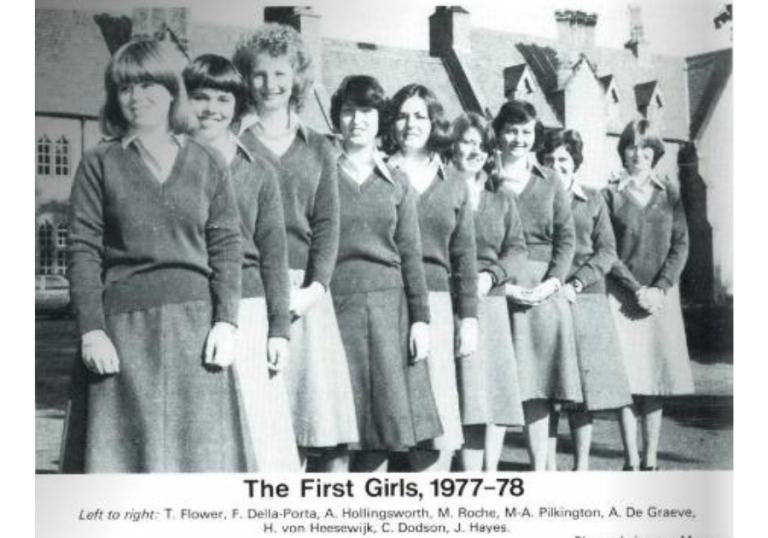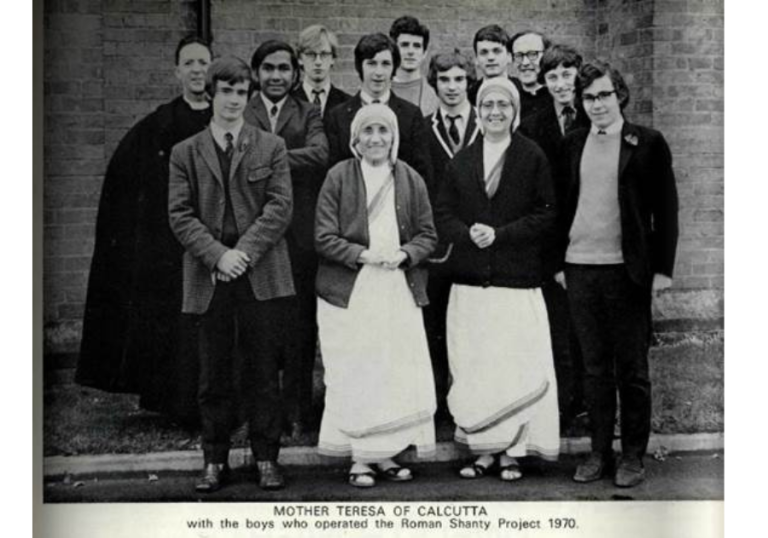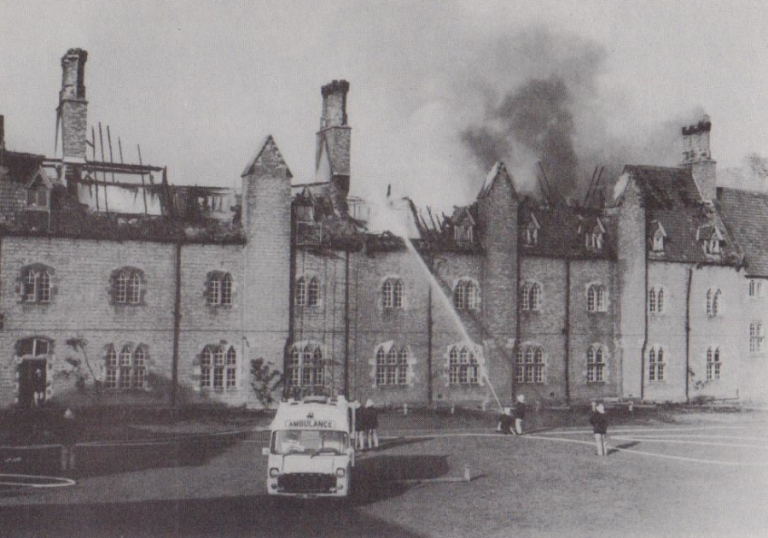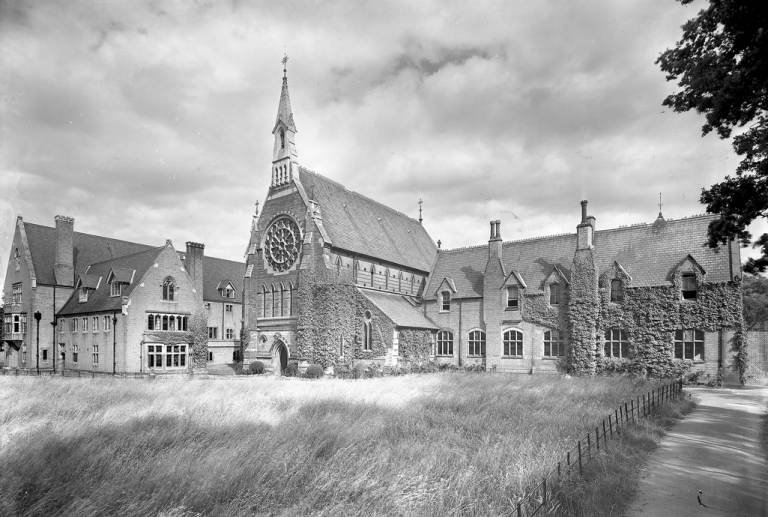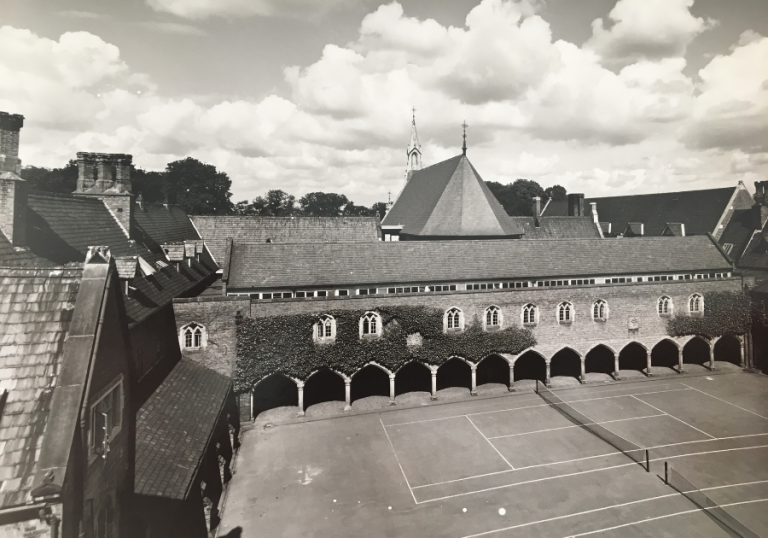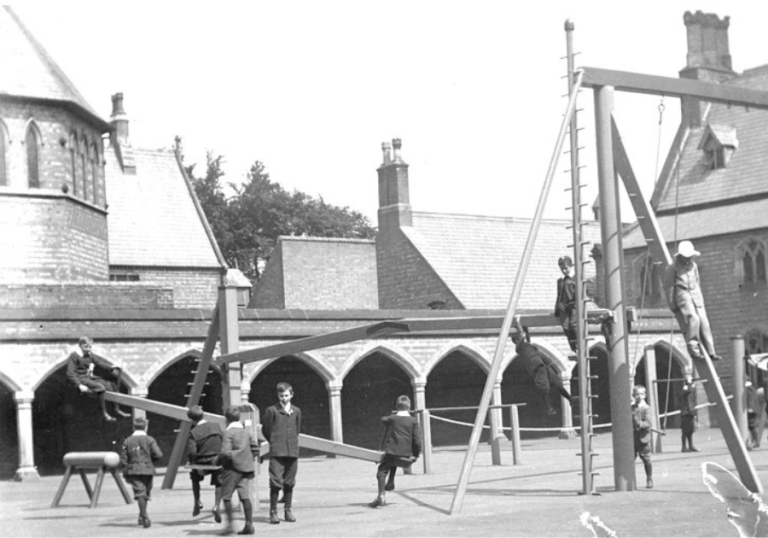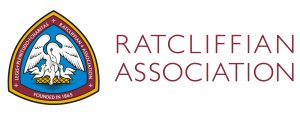Read about the history of Ratcliffe College
Ratcliffe College was opened on Tuesday 1st. June 1847, appropriately The Feast of Our Blessed Lady Help of Christians. The school started with only two pupils, John Foy from London and Joseph Roskill from Liverpool. They came to find a school building almost identical to the present front façade. Their arrival coincided with the opening of “A beautiful little Gothic Church” as described in an article in the Tablet, and which is now the Old Library.
The Rosminians – or – more correctly “the Institute of Charity” had been founded in 1828 by the saintly Antonio Rosmini and it was barely seven years after this that, in answer to several requests, the first missioners arrived in England to teach in the College and Seminary of Prior Park, near Bath, where they remained for several years. The best known of these men was Reverend Doctor Luigi Gentili. He was the first Catholic priest to preach publicly since the Reformation, and when he did so was stoned. He commenced his great missionary work in the little village of Shepshed near Grace Dieu where he became Chaplain to the de Lisle family. As men began to join the Order it soon became apparent that a Noviciate was needed and so land was purchased at Ratcliffe and plans were drawn up for a Noviciate and College. The latter at the urging of Gentili, who, with Rosmini, can be considered as the founders of the school.
The architect chosen was Augustus Welby Northmore Pugin who had designed the Palace of Westminster. Many of Pugin’s designs were far too grandiose and exceeded the amount the budget would allow. Nevertheless in 1844, the Noviciate was opened. The building stretched from the present Administration Office as far as the current Bursar’s Office, and its width extended only as far as the line of arches outside the Headmaster’s Office. Before the school opened in 1847 the front was extended northwards to join up with Pugin’s new Chapel – the present Old Library. The next twenty years witnessed a steady expansion of the buildings until the colonnade was built and, behind it, the much larger Chapel of 1867. Pugin’s original plan for the ‘Great Church’ had to be rejected by his son Edward after his father’s death in 1852, and a far more modest chapel was built which was to serve the school for almost 100 years.
Ratcliffe went through the nineteenth century reasonably calmly under Father Hutton’s Presidency, as the Headmaster was known, which lasted from 1850 – 1880. The highest number of pupils during his years of office was 125. He died in office at the age of 80. The next significant Presidency was that of Fr Joseph Cremonini (1895 – 1919) who had the difficult and sad task of steering the College through the First World War in which fifty-five Old Boys lost their lives. Amongst the saddest letters in the archives are those written to him, often from distressed parents of those who had died. The first parade of the Cadet Corps was made in 1915, to quell the eager spirit of the boys, after a visit by the Leicestershire Yeomanry. The Cadet Corps ceased in 1918 and was reinstated in 1956.
The next large building project was the erection of the fine school refectory and dormitory above in 1913. The stained glass windows in the Refectory depict the Arms of De Lisle and those of St Pius X. The tables and chairs, donated in 1936 by the Ratcliffian Association bear the names of the donors. The well-known craftsman, Robert ‘Mousey’ Thompson, whose famous trademark was the carving of a small mouse, made the refectory furniture and was reported to have said that it should last 400 years.
The greatest expansion bringing the College almost into a condition that could be recognised today came under the Presidency of Fr Cuthbert Emery (1923- 1948) The Music Department, Science Block and Gymnasium, which is today’s Theatre, were built. More playing fields, thanks to the Ratcliffian Association, and the Aerodrome, (this to prevent low flying airplanes which were becoming a danger to the school), were purchased The election of Fr Emery to the Headmasters’ Conference in 1945 meant that Ratcliffe became one of the country’s Public Schools. Fr Bill Murray served as Director of Studies during these years and it was he who was mainly instrumental in raising the academic standards of the school. There was a need by this time to cater for increased numbers of boys entering the school and to this end Grace Dieu Manor was leased in 1933 to serve as the Preparatory School for Ratcliffe. The age of entry into Ratcliffe was raised to 13 years. Fr Emery guided the School through the very difficult years of the Second World War, which saw nearly forty Old Boys give their lives for their country.
Fr Emery retired as President in 1948 and Fr Claude Leetham, who had been his Vice President, succeeded him. Fr Leetham was a forceful head and became well known in the world of catholic education. During his Presidency (1948-1962) more buildings were erected, an upper floor to the Science Block with its sixth form studies, and finally the present Chapel as a memorial to all those who died in the service of their country in the two World Wars. There was also the conversion of the old Chapel. Fr Leetham did much to influence boys when they left school or when they finally left University, to take an active part in public life, with considerable success. In 1956 a contingent of the Combined Cadet Corps, comprising an Army and a Royal Air Force section was set up under the command of Major John Radford, an Old boy, who had won the Croix de guerre and the Military Cross in the First World War.
Fr John Morris succeeded Fr Leetham and presided over the continuing expansion in numbers. A more liberated approach to the care of the Sixth Form – largely due to Fr Nann – and building of the hexagonal classroom blocks as well as the Sixth Form Union, took place. In 1948 twelve boys had joined the Rosminian noviciate, and the subsequent years to the end of the 1950s could well be described as the vintage years for vocations. In the early 1960s there was a religious community of almost thirty at the College. Since that time the staff has steadily expanded to include many loyal and devoted teachers – men and women – who have happily imbibed the Spirit of Ratcliffe.
As boys boarding became a less popular option, girl boarders were admitted to the Sixth Form under Fr Tony Baxter (1973-1982) at the end of the seventies. At the same time a limited number of day pupils were admitted. Shortly after, under the Presidency of Fr Bill Fearon (1982-1983), a small Junior Department, also for day boys, was added. Finally girls were accepted throughout the school, which was now fully co-educational. This occurred under the Presidency of Fr Lance Hurdidge (1983-1993). His idea of a Junior School for 11-13 year olds was expanded into the Newman, named after Cardinal John Henry Newman who had visited Ratcliffe in 1847. The most recent additions to Ratcliffe have been the Nursery School, opened in 1999 and the extension of the Junior Department both have proved to be most popular.
By the eighties with the shortage of religious vocations, it became clear that control would gradually be handed over to lay administration, a programme that reached its culmination when Fr Keith Tomlinson (1993-1996) retired as President. The first lay Headmaster was Mr. Tim Kilbride.
Ratcliffe has had its fair share of colourful characters. Science was introduced in the unfashionably early year of 1867. Brother Capella, an extraordinary man, besides making much of his equipment, was one of the first to make use of X-rays, which he did on an Egyptian mummy housed in the museum in the Old Library. Much later in the twentieth century, Brother Anthony Primavesi, after launching the Biology Department, introduced the Metalwork and Engineering classes. He invented an automatic clock and bell system, and built and installed the filtration plant for the outdoor swimming pool. Well known past pupils have included Clergy amongst whom are Bishops Burton, Ellis, and Restieux, also Fr Willie Doyle S.J. M.C. Many Old Ratcliffians have served, or are serving with distinction in the Medical profession and in the Armed Forces. Countless others have gone on to live successful and fulfilled lives. Rosmini famously commented that a school was worth twenty parishes in the benefit it could give to the Catholic Community.
Sport has been an intrinsic part of the life of Ratcliffe’s pupils, some sports have seen the passing of time, such as ice-skating and swimming and fishing in the Wreake, bandy, boxing and rowing. In the early 1920’s a swimming pool was built and remained in situ until 2001 when the pool was modernised and covered. Cricket, football and rugby have always been firm favourites and new sports such as hockey and netball have become part of the curriculum. The Square Mile, which began as the Half Mile Flat Race in may 1901, was run by boys from the College, on to the Sileby road, through the Long Wood by the A46 and up the front of the school. Today, it is run around the perimeter of the school and the winner is awarded the Jee Memorial Cup.
In the early 1900’s boys were divided into two teams; North and South, in later years as the number of boys increased, they were divided in to Lockhart (after a founding Father), Arundell, and de Lisle (after benefactors). In later years, Leetham replaced Lockhart and Emery added to make up the four teams that remain the same today.
The debating society, music and theatre productions all have recognition in the earliest recorded days of Ratcliffe’s life.
Nowadays, Ratcliffe has over 600 pupils, caters for a very wide range of students, from children aged three in the Nursery to young adults of eighteen in the Sixth Form. Buildings have been adapted and new ones constructed. The School is run on a self-financing basis, as opposed to the many years when capital projects depended to a large extent upon the resources of the Order. The Ratcliffian Association, financed, amongst other things, the building of the Cricket Pavilion, much of the new Chapel, the Sports Hall, the All Weather Pitch and the covering of the Swimming Pool has done much to help the school. The Association, which is for Past Pupils, is deemed to be one of the strongest in the country and continues to be active in support of its members and of the school. The traditional annual cricket match between the college and past pupils has been played since the origin of the Association in 1865.
At the heart of Ratcliffe College remains the Chapel and the desire to produce pupils who have achieved their potential in the context of a clear realisation of their place in God’s creation.
The history of the school has been recorded in ‘The Ratcliffian’ magazine since 1880 and Ratcliffe is proud of the wealth of archive material it conserves. In 1950, Fr C R Leetham published the history of Ratcliffe from 1847-1947. There are limited copies of this book avaialbe from the Ratcliffian Association.
